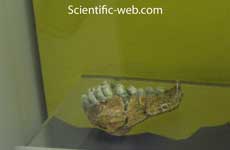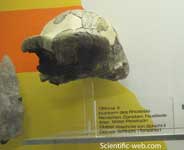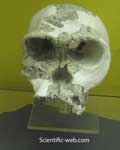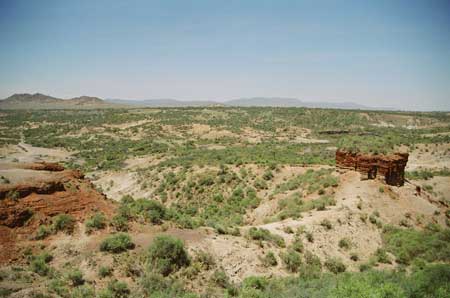The Olduvai Gorge or Oldupai Gorge is commonly referred to as "The Cradle of Mankind." It is a steep-sided ravine in the Great Rift Valley, which stretches along eastern Africa. Olduvai is in the eastern Serengeti Plains in northern Tanzania and is about 30 miles (48 km) long. The gorge is named after the Maasai word for the wild sisal plant Sansevieria ehrenbergii, commonly called Oldupaai.
Olduvai Gorge (*) It is one of the most important prehistoric sites in the world and has been instrumental in furthering understanding of early human evolution. Excavation work there was pioneered by Louis and Mary Leakey in the 1950s and continued into the twenty first century by Professor Fidelis Masao of the Open University of Tanzania supported by Earthwatch; there have also been teams from Rutgers University. Millions of years ago, the site was that of a large lake, the shores of which were covered with successive deposits of volcanic ash. Around 500,000 years ago seismic activity diverted a nearby stream which began to cut down into the sediments, revealing seven main layers in the walls of the gorge. The stratigraphy is extremely deep and layers of volcanic ash and stones allow radiometric dating of the embedded artifacts, mostly through potassium-argon dating. The first artifacts in Olduvai (pebble tools and choppers) date to circa 2 million years ago but fossil remains of human ancestors have been found from as long as 2.5 million years ago. The earliest archaeological deposit, known as Bed I, has produced evidence of campsites and living floors along with stone tools made of flakes from local basalt and quartz. Since this is the site where these kinds of tools were first discovered, these tools are called Oldowan. It is now thought that the Oldowan toolmaking tradition started about 2.6 million years ago. Bones from this layer are not of modern humans but primitive hominid forms of Paranthropus boisei and the first discovered specimens of Homo habilis. The Olduvai Gorge bears the distinction of having the oldest known evidence of Elephant consumption, attributed to Homo ergaster around 1.8 million years ago. Above this, in Bed II, pebble tools begin to be replaced by more sophisticated handaxes of the Acheulean industry and made by Homo ergaster. This layer dates to around 1.5 million years ago. Beds III and IV have produced Acheulean tools and fossil bones from more than 600,000 years ago. During a period of major faulting and volcanism roughly 400,000 to 600,000 years ago, the Masek Beds were made. Beds above these contained tools from a Kenya-Capsian industry made by modern humans and are termed the Masek Beds (600,000 to 400,000 years ago), the Ndutu Beds (400,000 to 32,000 years ago), and the Naisiusiu Beds (22,000 to 15,000 years ago). Also located on the rim of the Gorge is the Olduvai Gorge Museum. This Museum presents exhibitions pertaining to the Gorge's history. Other uses Olduvai is the location of the first monolith in Arthur C. Clarke's 2001: A Space Odyssey series of books. Olduvai is also the theme of the Olduvai theory, which states that industrial civilization will have a lifetime of less than or equal to 100 years. The variant "Oldupai" is the Maasai word for the wild Sisal plant that grows in the gorge; some claim the more common spelling "Olduvai" is the result of a mis-hearing of the word by colonial visitors. The latter spelling is not used locally. Olduvai is the name of the Mars location in the Doom movie. Seven Views of Olduvai Gorge is a 1994 novella by science fiction author Mike Resnick. It won the year's Nebula Award for Best Novella and the 1995 Hugo Award for Best Novella. The story concerns an archaeological expedition sent to Earth after humanity's alleged extinction. References * Cole, Sonia (1975) Leakey’s Luck. Harcourt Brace Jovanvich, New York. See also * List of fossil sites External links
Retrieved from "http://en.wikipedia.org/" |
|




